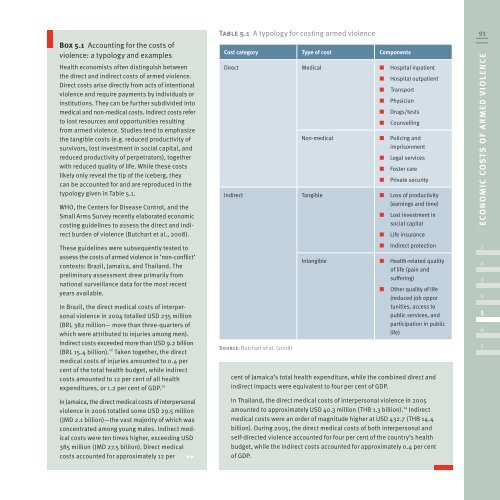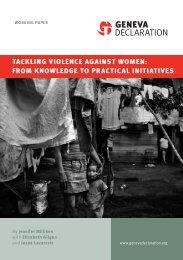Global Burden of Armed Violence - The Geneva Declaration on ...
Global Burden of Armed Violence - The Geneva Declaration on ...
Global Burden of Armed Violence - The Geneva Declaration on ...
You also want an ePaper? Increase the reach of your titles
YUMPU automatically turns print PDFs into web optimized ePapers that Google loves.
Box 5.1 Accounting for the costs <str<strong>on</strong>g>of</str<strong>on</strong>g><br />
violence: a typology and examples<br />
Health ec<strong>on</strong>omists <str<strong>on</strong>g>of</str<strong>on</strong>g>ten distinguish between<br />
the direct and indirect costs <str<strong>on</strong>g>of</str<strong>on</strong>g> armed violence.<br />
Direct costs arise directly from acts <str<strong>on</strong>g>of</str<strong>on</strong>g> intenti<strong>on</strong>al<br />
violence and require payments by individuals or<br />
instituti<strong>on</strong>s. <str<strong>on</strong>g>The</str<strong>on</strong>g>y can be further subdivided into<br />
medical and n<strong>on</strong>-medical costs. Indirect costs refer<br />
to lost resources and opportunities resulting<br />
from armed violence. Studies tend to emphasize<br />
the tangible costs (e.g. reduced productivity <str<strong>on</strong>g>of</str<strong>on</strong>g><br />
survivors, lost investment in social capital, and<br />
reduced productivity <str<strong>on</strong>g>of</str<strong>on</strong>g> perpetrators), together<br />
with reduced quality <str<strong>on</strong>g>of</str<strong>on</strong>g> life. While these costs<br />
likely <strong>on</strong>ly reveal the tip <str<strong>on</strong>g>of</str<strong>on</strong>g> the iceberg, they<br />
can be accounted for and are reproduced in the<br />
typology given in Table 5.1.<br />
WHO, the Centers for Disease C<strong>on</strong>trol, and the<br />
Small Arms Survey recently elaborated ec<strong>on</strong>omic<br />
costing guidelines to assess the direct and indirect<br />
burden <str<strong>on</strong>g>of</str<strong>on</strong>g> violence (Butchart et al., 2008).<br />
<str<strong>on</strong>g>The</str<strong>on</strong>g>se guidelines were subsequently tested to<br />
assess the costs <str<strong>on</strong>g>of</str<strong>on</strong>g> armed violence in ‘n<strong>on</strong>-c<strong>on</strong>flict’<br />
c<strong>on</strong>texts: Brazil, Jamaica, and Thailand. <str<strong>on</strong>g>The</str<strong>on</strong>g><br />
preliminary assessment drew primarily from<br />
nati<strong>on</strong>al surveillance data for the most recent<br />
years available.<br />
In Brazil, the direct medical costs <str<strong>on</strong>g>of</str<strong>on</strong>g> interpers<strong>on</strong>al<br />
violence in 2004 totalled USD 235 milli<strong>on</strong><br />
(BRL 382 milli<strong>on</strong>— more than three-quarters <str<strong>on</strong>g>of</str<strong>on</strong>g><br />
which were attributed to injuries am<strong>on</strong>g men).<br />
Indirect costs exceeded more than USD 9.2 billi<strong>on</strong><br />
(BRL 15.4 billi<strong>on</strong>). 12 Taken together, the direct<br />
medical costs <str<strong>on</strong>g>of</str<strong>on</strong>g> injuries amounted to 0.4 per<br />
cent <str<strong>on</strong>g>of</str<strong>on</strong>g> the total health budget, while indirect<br />
costs amounted to 12 per cent <str<strong>on</strong>g>of</str<strong>on</strong>g> all health<br />
expenditures, or 1.2 per cent <str<strong>on</strong>g>of</str<strong>on</strong>g> GDP. 13<br />
In Jamaica, the direct medical costs <str<strong>on</strong>g>of</str<strong>on</strong>g> interpers<strong>on</strong>al<br />
violence in 2006 totalled some USD 29.5 milli<strong>on</strong><br />
(JMD 2.1 billi<strong>on</strong>)—the vast majority <str<strong>on</strong>g>of</str<strong>on</strong>g> which was<br />
c<strong>on</strong>centrated am<strong>on</strong>g young males. Indirect medical<br />
costs were ten times higher, exceeding USD<br />
385 milli<strong>on</strong> (JMD 27.5 billi<strong>on</strong>). Direct medical<br />
costs accounted for approximately 12 per ##<br />
Table 5.1 A typology for costing armed violence<br />
Cost category Type <str<strong>on</strong>g>of</str<strong>on</strong>g> cost Comp<strong>on</strong>ents<br />
Direct Medical !"Hospital inpatient<br />
!"Hospital outpatient<br />
!"Transport<br />
!"Physician<br />
!"Drugs/tests<br />
!"Counselling<br />
N<strong>on</strong>-medical !"Policing and<br />
impris<strong>on</strong>ment<br />
!"Legal services<br />
!"Foster care<br />
!"Private security<br />
Indirect Tangible !"Loss <str<strong>on</strong>g>of</str<strong>on</strong>g> productivity<br />
(earnings and time)<br />
Source: Butchart et al. (2008)<br />
!"Lost investment in<br />
social capital<br />
!"Life insurance<br />
!"Indirect protecti<strong>on</strong><br />
Intangible !"Health-related quality<br />
<str<strong>on</strong>g>of</str<strong>on</strong>g> life (pain and<br />
suffering)<br />
!"Other quality <str<strong>on</strong>g>of</str<strong>on</strong>g> life<br />
(reduced job oppor<br />
tunities, access to<br />
public services, and<br />
participati<strong>on</strong> in public<br />
life)<br />
cent <str<strong>on</strong>g>of</str<strong>on</strong>g> Jamaica’s total health expenditure, while the combined direct and<br />
indirect impacts were equivalent to four per cent <str<strong>on</strong>g>of</str<strong>on</strong>g> GDP.<br />
In Thailand, the direct medical costs <str<strong>on</strong>g>of</str<strong>on</strong>g> interpers<strong>on</strong>al violence in 2005<br />
amounted to approximately USD 40.3 milli<strong>on</strong> (THB 1.3 billi<strong>on</strong>). 14 Indirect<br />
medical costs were an order <str<strong>on</strong>g>of</str<strong>on</strong>g> magnitude higher at USD 432.7 (THB 14.4<br />
billi<strong>on</strong>). During 2005, the direct medical costs <str<strong>on</strong>g>of</str<strong>on</strong>g> both interpers<strong>on</strong>al and<br />
self-directed violence accounted for four per cent <str<strong>on</strong>g>of</str<strong>on</strong>g> the country’s health<br />
budget, while the indirect costs accounted for approximately 0.4 per cent<br />
<str<strong>on</strong>g>of</str<strong>on</strong>g> GDP.<br />
93<br />
ECO N OMIC COS T S OF A R M E D V I O L E N C E<br />
1<br />
2<br />
3<br />
4<br />
5<br />
6<br />
7









